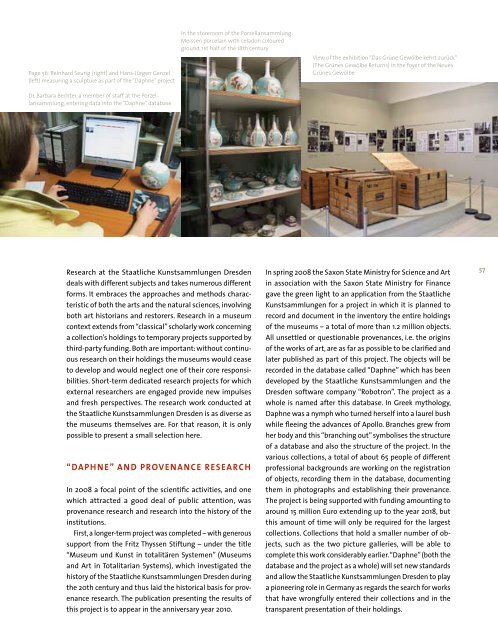2008 - Staatliche Kunstsammlungen Dresden
2008 - Staatliche Kunstsammlungen Dresden
2008 - Staatliche Kunstsammlungen Dresden
Create successful ePaper yourself
Turn your PDF publications into a flip-book with our unique Google optimized e-Paper software.
Page 56: Reinhard Seurig (right) and Hans-Jürgen Genzel<br />
(left) measuring a sculpture as part of the “Daphne” project<br />
Dr. Barbara Bechter, a member of staff at the Porzellansammlung,<br />
entering data into the “Daphne” database<br />
In the storeroom of the Porzellansammlung:<br />
Meissen porcelain with celadon coloured<br />
ground, 1st half of the 18th century<br />
Research at the <strong>Staatliche</strong> <strong>Kunstsammlungen</strong> <strong>Dresden</strong><br />
deals with different subjects and takes numerous different<br />
forms. It embraces the approaches and methods characteristic<br />
of both the arts and the natural sciences, involving<br />
both art historians and restorers. Research in a museum<br />
context extends from “classical” scholarly work concerning<br />
a collection’s holdings to temporary projects supported by<br />
third-party funding. Both are important: without continuous<br />
research on their holdings the museums would cease<br />
to develop and would neglect one of their core responsibilities.<br />
Short-term dedicated research projects for which<br />
external researchers are engaged provide new impulses<br />
and fresh perspectives. The research work conducted at<br />
the <strong>Staatliche</strong> <strong>Kunstsammlungen</strong> <strong>Dresden</strong> is as diverse as<br />
the museums themselves are. For that reason, it is only<br />
possible to present a small selection here.<br />
“DAPhNE” AND PROVENANCE REsEARCh<br />
In <strong>2008</strong> a focal point of the scientific activities, and one<br />
which attracted a good deal of public attention, was<br />
provenance research and research into the history of the<br />
institutions.<br />
First, a longer-term project was completed – with generous<br />
support from the Fritz Thyssen Stiftung – under the title<br />
“Museum und Kunst in totalitären Systemen” (Museums<br />
and Art in Totalitarian Systems), which investigated the<br />
history of the <strong>Staatliche</strong> <strong>Kunstsammlungen</strong> <strong>Dresden</strong> during<br />
the 20th century and thus laid the historical basis for provenance<br />
research. The publication presenting the results of<br />
this project is to appear in the anniversary year 2010.<br />
View of the exhibition “Das Grüne Gewölbe kehrt zurück”<br />
(The Grünes Gewölbe Returns) in the foyer of the Neues<br />
Grünes Gewölbe<br />
In spring <strong>2008</strong> the Saxon State Ministry for Science and Art<br />
in association with the Saxon State Ministry for Finance<br />
gave the green light to an application from the <strong>Staatliche</strong><br />
<strong>Kunstsammlungen</strong> for a project in which it is planned to<br />
record and document in the inventory the entire holdings<br />
of the museums – a total of more than 1.2 million objects.<br />
All unsettled or questionable provenances, i.e. the origins<br />
of the works of art, are as far as possible to be clarified and<br />
later published as part of this project. The objects will be<br />
recorded in the database called “Daphne” which has been<br />
developed by the <strong>Staatliche</strong> <strong>Kunstsammlungen</strong> and the<br />
<strong>Dresden</strong> software company “Robotron”. The project as a<br />
whole is named after this database. In Greek mythology,<br />
Daphne was a nymph who turned herself into a laurel bush<br />
while fleeing the advances of Apollo. Branches grew from<br />
her body and this “branching out” symbolises the structure<br />
of a database and also the structure of the project. In the<br />
various collections, a total of about 65 people of different<br />
professional backgrounds are working on the registration<br />
of objects, recording them in the database, documenting<br />
them in photographs and establishing their provenance.<br />
The project is being supported with funding amounting to<br />
around 15 million Euro extending up to the year 2018, but<br />
this amount of time will only be required for the largest<br />
collections. Collections that hold a smaller number of objects,<br />
such as the two picture galleries, will be able to<br />
complete this work considerably earlier. “Daphne” (both the<br />
database and the project as a whole) will set new standards<br />
and allow the <strong>Staatliche</strong> <strong>Kunstsammlungen</strong> <strong>Dresden</strong> to play<br />
a pioneering role in Germany as regards the search for works<br />
that have wrongfully entered their collections and in the<br />
transparent presentation of their holdings.<br />
5

















